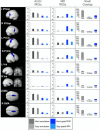Functional Characterization of the Human Speech Articulation Network
- PMID: 28453613
- PMCID: PMC5907347
- DOI: 10.1093/cercor/bhx100
Functional Characterization of the Human Speech Articulation Network
Abstract
A number of brain regions have been implicated in articulation, but their precise computations remain debated. Using functional magnetic resonance imaging, we examine the degree of functional specificity of articulation-responsive brain regions to constrain hypotheses about their contributions to speech production. We find that articulation-responsive regions (1) are sensitive to articulatory complexity, but (2) are largely nonoverlapping with nearby domain-general regions that support diverse goal-directed behaviors. Furthermore, premotor articulation regions show selectivity for speech production over some related tasks (respiration control), but not others (nonspeech oral-motor [NSO] movements). This overlap between speech and nonspeech movements concords with electrocorticographic evidence that these regions encode articulators and their states, and with patient evidence whereby articulatory deficits are often accompanied by oral-motor deficits. In contrast, the superior temporal regions show strong selectivity for articulation relative to nonspeech movements, suggesting that these regions play a specific role in speech planning/production. Finally, articulation-responsive portions of posterior inferior frontal gyrus show some selectivity for articulation, in line with the hypothesis that this region prepares an articulatory code that is passed to the premotor cortex. Taken together, these results inform the architecture of the human articulation system.
Figures




References
-
- Amunts K, Schleicher A, Bürgel U, Mohlberg H, Uylings H, Zilles K. 1999. Broca’s region revisited: cytoarchitecture and intersubject variability. J Comp Neurol. 412:319–341. - PubMed
-
- Baldo JV, Wilkins DP, Ogar J, Willock S, Dronkers N. 2011. Role of the precentral gyrus of the insula in complex articulation. Cortex. 47:800–807. - PubMed
-
- Ballard K, Robin D, Folkins J. 2003. An integrative model of speech motor control: a response to Ziegler. Aphasiology. 17:37–48.
-
- Ballard KJ, Granier JP, Robin DA. 2000. Understanding the nature of apraxia of speech: theory, analysis and treatment. Aphasiology. 14:969–995.
Publication types
MeSH terms
Substances
Grants and funding
LinkOut - more resources
Full Text Sources
Other Literature Sources

